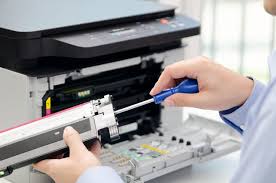
Affiliate Disclosure
Note: This banner contains an affiliate link. If you click and make a purchase, we may earn a commission at no extra cost to you. This helps us maintain and improve our content for users like you, supporting our travel site operations.
1. Introduction

Printers have become an essential part of modern life, from home offices to corporate settings. Whether you’re printing documents, photos, or business proposals, a reliable printer ensures smooth workflows. However, like all machines, printers require regular maintenance to operate efficiently. Neglecting their upkeep can lead to poor-quality prints, frequent breakdowns, and costly repairs.
This ultimate guide to printer maintenance provides comprehensive steps to keep your printer in pristine condition, ensuring optimal performance and longevity.
2. Understanding Your Printer

To effectively maintain your printer, you must first understand its types and components.
Types of Printers
- Inkjet Printers: Ideal for high-resolution photo and document printing but prone to ink clogs if not used regularly.
- Laser Printers: Known for speed and durability, making them perfect for high-volume printing. They require toner and roller maintenance.
- All-in-One Printers: Combine printing, scanning, and copying. While versatile, they demand comprehensive care to ensure all functions work smoothly.
Key Components of a Printer
- Print Head: Applies ink or toner to paper.
- Rollers: Feed paper through the printer.
- Cartridges/Toner: Store the ink or toner used for printing.
- Paper Tray: Holds paper in an organized manner for smooth feeding.
3. Benefits of Regular Printer Maintenance

Improved Performance
Regular maintenance ensures your printer produces clear, high-quality prints and operates without delays.
Cost Savings
Routine care minimizes the need for expensive repairs and prolongs the life of consumables like cartridges and rollers.
Extended Lifespan
Well-maintained printers last longer, reducing the frequency of replacements and saving you money in the long run.
4. Daily Printer Maintenance Tips

Proper Usage Habits
- Only use the printer when necessary to reduce wear and tear.
- Avoid repeatedly turning the printer on and off, which stresses internal components.
Avoid Overloading Paper Trays
- Overfilled trays often lead to paper jams.
- Use the manufacturer-recommended paper type and size.
5. Weekly Printer Maintenance Tasks

Clean the Exterior
Dust and debris can accumulate on your printer, potentially impacting performance. Wipe the exterior with a dry microfiber cloth to keep it clean.
Check Ink and Toner Levels
Running out of ink mid-print can damage print heads and waste paper. Always ensure cartridges are adequately filled.
Run Diagnostic Tests
Most printers feature built-in diagnostics to check component functionality. Running these tests weekly can help identify potential problems early.
6. Monthly Printer Maintenance Practices
Clean the Print Heads
- Streaky or faded prints often result from clogged print heads.
- Use the printer’s cleaning cycle or gently wipe the print heads with a lint-free cloth and isopropyl alcohol.
Inspect the Rollers
- Rollers can wear out over time, leading to paper jams or feeding issues.
- Clean them with a damp cloth to ensure smooth operation.
Update Firmware and Drivers
Outdated software can cause compatibility issues. Regularly check for updates on the manufacturer’s website to keep your printer running smoothly.
7. Advanced Maintenance for Laser and Inkjet Printers
For Inkjet Printers
- Regularly clean the nozzles to prevent clogs.
- Use the printer weekly to avoid ink drying out.
For Laser Printers
- Replace the toner cartridge when print quality declines.
- Clean the corona wire and drum unit to maintain sharp prints.
8. Preventing Common Printer Problems
Avoiding Paper Jams
- Always align paper properly in the tray.
- Avoid using bent, torn, or damp paper.
- Clean the rollers to ensure consistent feeding.
Addressing Connectivity Issues
- Keep your printer’s software and firmware updated.
- Ensure the printer and computer are on the same network.
- Restart the router and printer to resolve network conflicts.
9. Signs Your Printer Needs Professional Maintenance

Unusual Noises
Grinding or clicking sounds often signal internal damage or worn-out components.
Persistent Error Messages
If basic troubleshooting doesn’t resolve errors, a professional technician can provide a solution.
10. Printer Maintenance for Office Environments
Maintenance Schedules
- Assign individuals or teams to oversee maintenance tasks.
- Establish weekly, monthly, and quarterly routines for upkeep.
Handling High-Volume Usage
- Use high-capacity cartridges and paper trays.
- Frequently inspect and replace worn components to avoid downtime.
11. Eco-Friendly Printer Maintenance
Recycling Cartridges
Many manufacturers offer recycling programs for used cartridges, reducing environmental waste.
Energy-Saving Practices
- Enable sleep mode when the printer is idle.
- Turn off the printer after office hours to conserve energy.
Conclusion
Printer maintenance is essential for maintaining performance, reducing costs, and extending device life. Whether you’re managing a home printer or a fleet of office devices, following this guide ensures hassle-free printing for years to come.

